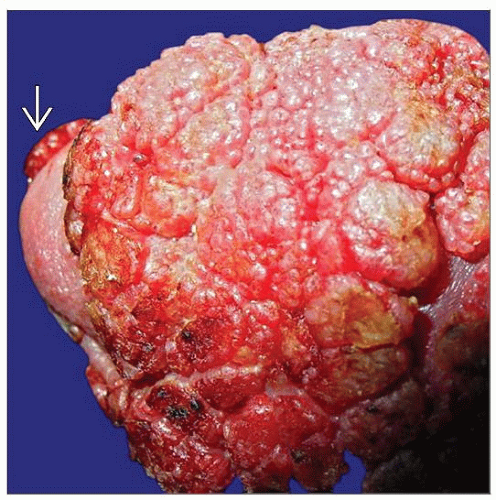HPV-associated Lesions
Antonio L. Cubilla, MD
Alcides Chaux, MD
Elsa F. Velazquez, MD
Key Facts
Terminology
Synonyms include condyloma acuminatum and giant condyloma
Exophytic and verruciform nonmalignant epithelial tumors
Clear predilection for anogenital area
Condyloma acuminatum is relatively common and giant condyloma is very unusual
Etiology/Pathogenesis
Evidence of HPV infection found in most cases
Low-risk HPV serotypes (6, 11) predominates
Macroscopic Features
Papillary cauliflower-like exophytic tumor
Size range: Few mm to several cm
Microscopic Pathology
Arborescent papillae with prominent fibrovascular cores
Papillomatosis, acanthosis, hyper- and parakeratosis in variable degrees
Broad and sharply defined tumoral base
Conspicuous koilocytosis
Morphological features in giant condyloma are more prominent
Giant condyloma presents endophytic pattern of growth
Top Differential Diagnoses
Warty, papillary, and verrucous carcinomas
Condyloma with malignization
Papillomatosis of glans corona
TERMINOLOGY
Abbreviations
Human papillomavirus (HPV)
Synonyms
Genital wart, benign or typical condyloma (condyloma acuminatum)
Buschke-Löwenstein tumor (giant condyloma)
Definitions
Exophytic and verruciform nonmalignant epithelial lesions
ETIOLOGY/PATHOGENESIS
Infectious Agents
Evidence of HPV infection found in most cases
Low-risk serotypes (6, 11) predominate
Incidence of HPV-6 is higher than HPV-11
Other serotypes identified include 16, 18, 30-32, 42-44, and 51-55
CLINICAL ISSUES
Epidemiology
Incidence
Condyloma acuminatum
Very common in sexually active young males
Giant condyloma
Very unusual
Age
Condyloma acuminatum
Prevalence is higher in 2nd to 3rd decades of life
Giant condyloma
Patients tend to be older than those with condyloma acuminatum
Site
Predilection for anogenital area
Condyloma acuminatum
Glans is most frequently affected site, followed by foreskin, meatus urethralis, and penile shaft
Giant condyloma
Tend to affect foreskin and coronal sulcus
Presentation
Clinically may be confused with molluscum contagiosum, Fordyce spots, or condyloma latum
Diagnosis is straightforward on histological grounds
Treatment
For small tumors: Cryosurgery, electrofulguration, laser ablation, and topical treatments
For medium-sized and large tumors: Surgical excision
Giant condyloma: Wide local excision
Prognosis
Malignant transformation is rare in condyloma acuminatum
Giant condyloma has tendency to locally recur
Giant condyloma often harbors carcinomatous foci
Increased risk for anogenital cancers
MACROSCOPIC FEATURES
General Features
Papillary cauliflower-like exophytic tumor
Size ranges from few mm to several cm
Average size of giant condylomata is 5-10 cm
MICROSCOPIC PATHOLOGY
Histologic Features
Arborescent papillae with prominent fibrovascular cores
Variable parakeratosis and orthokeratosis
Conspicuous surface koilocytosis
Typical koilocytes exhibit perinuclear vacuolization, wrinkled and hyperchromatic nuclei with frequent binucleation
Sharply defined base that is broad and pushing
Morphological features in giant condyloma are more prominent
Giant condyloma presents characteristic and evident endophytic pattern of growth
Cutaneous fistulae can sometimes be observed with giant condyloma
DIFFERENTIAL DIAGNOSIS
Warty Carcinoma
Affects older patients
Higher cytologic grade and nuclear atypia
Koilocytes frequently show pleomorphism
More abundant mitoses
Jagged and irregular tumor base
Stromal invasion
Presence of high-risk HPV
Usually positive for p16 overexpression
Papillary Carcinoma, NOS
Papillomatosis with acanthosis and hyperkeratosis
Stay updated, free articles. Join our Telegram channel

Full access? Get Clinical Tree






